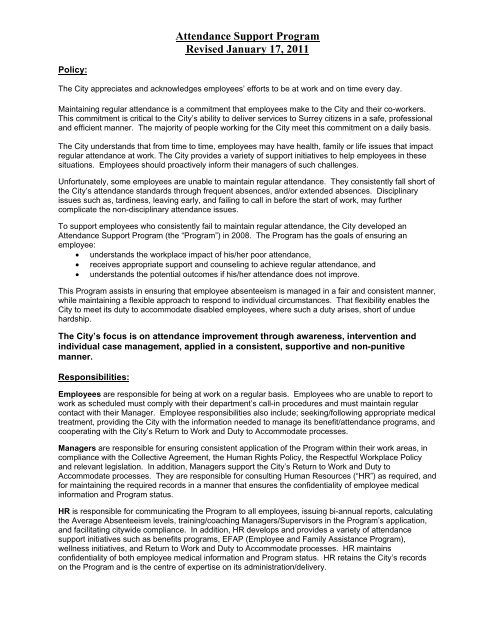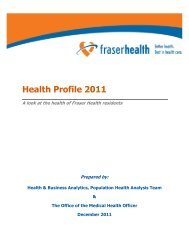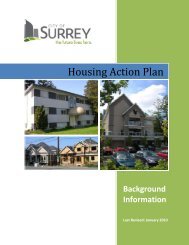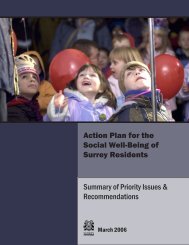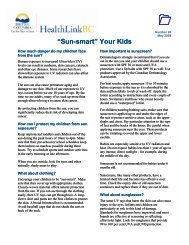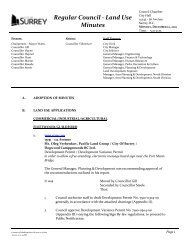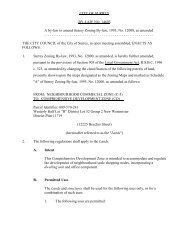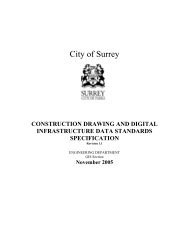Attendance Support Program - City of Surrey
Attendance Support Program - City of Surrey
Attendance Support Program - City of Surrey
Create successful ePaper yourself
Turn your PDF publications into a flip-book with our unique Google optimized e-Paper software.
<strong>Attendance</strong> <strong>Support</strong> <strong>Program</strong><br />
Revised January 17, 2011<br />
Policy:<br />
The <strong>City</strong> appreciates and acknowledges employees’ efforts to be at work and on time every day.<br />
Maintaining regular attendance is a commitment that employees make to the <strong>City</strong> and their co-workers.<br />
This commitment is critical to the <strong>City</strong>’s ability to deliver services to <strong>Surrey</strong> citizens in a safe, pr<strong>of</strong>essional<br />
and efficient manner. The majority <strong>of</strong> people working for the <strong>City</strong> meet this commitment on a daily basis.<br />
The <strong>City</strong> understands that from time to time, employees may have health, family or life issues that impact<br />
regular attendance at work. The <strong>City</strong> provides a variety <strong>of</strong> support initiatives to help employees in these<br />
situations. Employees should proactively inform their managers <strong>of</strong> such challenges.<br />
Unfortunately, some employees are unable to maintain regular attendance. They consistently fall short <strong>of</strong><br />
the <strong>City</strong>’s attendance standards through frequent absences, and/or extended absences. Disciplinary<br />
issues such as, tardiness, leaving early, and failing to call in before the start <strong>of</strong> work, may further<br />
complicate the non-disciplinary attendance issues.<br />
To support employees who consistently fail to maintain regular attendance, the <strong>City</strong> developed an<br />
<strong>Attendance</strong> <strong>Support</strong> <strong>Program</strong> (the “<strong>Program</strong>”) in 2008. The <strong>Program</strong> has the goals <strong>of</strong> ensuring an<br />
employee:<br />
• understands the workplace impact <strong>of</strong> his/her poor attendance,<br />
• receives appropriate support and counseling to achieve regular attendance, and<br />
• understands the potential outcomes if his/her attendance does not improve.<br />
This <strong>Program</strong> assists in ensuring that employee absenteeism is managed in a fair and consistent manner,<br />
while maintaining a flexible approach to respond to individual circumstances. That flexibility enables the<br />
<strong>City</strong> to meet its duty to accommodate disabled employees, where such a duty arises, short <strong>of</strong> undue<br />
hardship.<br />
The <strong>City</strong>’s focus is on attendance improvement through awareness, intervention and<br />
individual case management, applied in a consistent, supportive and non-punitive<br />
manner.<br />
Responsibilities:<br />
Employees are responsible for being at work on a regular basis. Employees who are unable to report to<br />
work as scheduled must comply with their department’s call-in procedures and must maintain regular<br />
contact with their Manager. Employee responsibilities also include; seeking/following appropriate medical<br />
treatment, providing the <strong>City</strong> with the information needed to manage its benefit/attendance programs, and<br />
cooperating with the <strong>City</strong>’s Return to Work and Duty to Accommodate processes.<br />
Managers are responsible for ensuring consistent application <strong>of</strong> the <strong>Program</strong> within their work areas, in<br />
compliance with the Collective Agreement, the Human Rights Policy, the Respectful Workplace Policy<br />
and relevant legislation. In addition, Managers support the <strong>City</strong>’s Return to Work and Duty to<br />
Accommodate processes. They are responsible for consulting Human Resources (“HR”) as required, and<br />
for maintaining the required records in a manner that ensures the confidentiality <strong>of</strong> employee medical<br />
information and <strong>Program</strong> status.<br />
HR is responsible for communicating the <strong>Program</strong> to all employees, issuing bi-annual reports, calculating<br />
the Average Absenteeism levels, training/coaching Managers/Supervisors in the <strong>Program</strong>’s application,<br />
and facilitating citywide compliance. In addition, HR develops and provides a variety <strong>of</strong> attendance<br />
support initiatives such as benefits programs, EFAP (Employee and Family Assistance <strong>Program</strong>),<br />
wellness initiatives, and Return to Work and Duty to Accommodate processes. HR maintains<br />
confidentiality <strong>of</strong> both employee medical information and <strong>Program</strong> status. HR retains the <strong>City</strong>’s records<br />
on the <strong>Program</strong> and is the centre <strong>of</strong> expertise on its administration/delivery.
Application:<br />
This <strong>Program</strong> applies to all <strong>City</strong> employees, except temporary, term, auxiliary status and employees in<br />
their probationary period, who must meet a higher standard <strong>of</strong> attendance. This <strong>Program</strong> does not apply<br />
to Library and Fire employees, who have their own attendance programs.<br />
This <strong>Program</strong> does not apply to situations involving chronic long-term absences (e.g. LTD, WCB),<br />
disciplinary absenteeism (absence without leave, lateness, early quits, etc.), or when an employee’s<br />
absenteeism is related to a documented disability.<br />
• <strong>Program</strong> Design<br />
The <strong>City</strong> reserves its right to periodically modify and re-communicate this <strong>Program</strong>.<br />
THE ATTENDANCE SUPPORT PROGRAM:<br />
In January and July <strong>of</strong> each year (at a minimum), HR issues to managers an attendance report by work<br />
group that identifies the percentage and hours <strong>of</strong> absences for each employee in that work group for the<br />
previous twelve-month period. The report also shows the 6-month attendance trend. The report may be<br />
amended from time to time to meet the needs <strong>of</strong> <strong>Program</strong> users.<br />
HR calculates and issues to Management and the Union, a <strong>City</strong> Average Absenteeism Level for the<br />
previous 12 months (the “<strong>City</strong> Average”). Separate Absenteeism Averages are calculated for the<br />
following:<br />
• Exempt<br />
• Outside Workers (the “Outside Average”)<br />
• Inside Workers (the “Inside Average”).<br />
The outside and inside averages are further calculated to account for regular workdays, 10-hour<br />
workdays and 12-hour workdays. The <strong>City</strong> Average is posted on the <strong>City</strong>’s intranet to support employee<br />
awareness.<br />
The <strong>City</strong> Average is calculated using hours worked versus hours scheduled and are reported in hours<br />
(scheduled and absent) and as a percentage. Absences, including paid and unpaid sick days,<br />
unauthorized leaves <strong>of</strong> absence, etc. will be considered hours scheduled, in addition to the actual hours<br />
worked. Absences not included in hours scheduled are those expressly provided for in agreements,<br />
contracts and legislation such as, vacation days, holidays, paid education, Workers Compensation,<br />
disciplinary suspensions, bereavement leave, union business, authorized leave <strong>of</strong> absences, maternity<br />
leave, parental leave, authorized family leave, long term disability, etc.<br />
The <strong>Program</strong> is designed as a progressive 2-way communication with employees. It involves a series <strong>of</strong><br />
discussions over a period <strong>of</strong> time to support improved attendance. The <strong>City</strong>’s goal is to support employee<br />
attendance success through heightened awareness, progressive discussions, early intervention and<br />
individual case management.<br />
Employee Recognition<br />
Managers should recognize employees with excellent attendance and/or improving attendance records<br />
where possible. The <strong>City</strong> has an annual Perfect <strong>Attendance</strong> <strong>Program</strong> that recognizes perfect attendance<br />
in a formal documented method. However, managers are encouraged to periodically, verbally or in<br />
writing, commend staff with good attendance rates and those staff showing improvement in achieving<br />
below average absenteeism.<br />
January 11, 2011
<strong>Attendance</strong> <strong>Support</strong> <strong>Program</strong> Processes:<br />
Information Review:<br />
Before placing an employee on the <strong>Program</strong>, removing an employee from the <strong>Program</strong>, leaving the<br />
employee on a step <strong>of</strong> the <strong>Program</strong>, or progressing an employee from one-step in the <strong>Program</strong> to the<br />
next, a manager reviews the absence report for his/her work group against the applicable <strong>City</strong> Average<br />
and identifies all employees who exceed the applicable Average.<br />
For employees with absences above the applicable <strong>City</strong> Average, the Manager will review his/her<br />
understanding <strong>of</strong> the justification for the excessive absences, the employee’s prior attendance record and<br />
the 6 th month trend pattern, to determine if any further action is required. Factors to be considered<br />
include a marked change in attendance performance, absences with no explanation, a pattern showing<br />
certain days being missed (e.g. extended weekends), failure to call-in, declining work performance, the<br />
number <strong>of</strong> absences, repeated tardiness, and attendance rates chronically above the <strong>City</strong> Average.<br />
The main question to be considered by the Manager in the review is; “Can the employee’s attendance<br />
issue be explained by a recent circumstance or is there a concern <strong>of</strong> an ongoing pattern with no valid<br />
explanation?” HR is available to assist the Manager in this review.<br />
If after this information review, the Manager concludes that there is no ongoing attendance concern, no<br />
discussion will occur with the employee unless future attendance problems arise.<br />
The Manager notes his/her decision not to progress on the attendance report and returns the information<br />
to HR.<br />
Step 1:<br />
Purpose: To enable the Manager to understand if there is an attendance issue and to ensure the<br />
employee understands both the support available to achieve better attendance and the potential<br />
consequences if the attendance issues are not resolved.<br />
If after the reviewing the attendance report and related information, the Manager concludes that a<br />
discussion is required with the employee to further understand the attendance record and potentially<br />
provide formal coaching, the Manager will meet with the employee in a review meeting. If the employee<br />
does not have an active <strong>Attendance</strong> <strong>Program</strong> letter on file then a Step 1 review is appropriate. The Union<br />
should attend the Step 1 review meeting.<br />
Review Meeting:<br />
1. In the review meeting, the Manager reviews the <strong>Attendance</strong> <strong>Support</strong> <strong>Program</strong> with the employee<br />
and provides the employee with a copy <strong>of</strong> the <strong>Program</strong> and the ASP pamphlet.<br />
2. The Manager then:<br />
• Asks the employee to explain his/her attendance record,<br />
• Discusses reasons for the employee’s level <strong>of</strong> absenteeism,<br />
• Advises the employee <strong>of</strong> the support resources available (Employee Family Assistance<br />
<strong>Program</strong>, Union Rep, Occupational Health & Safety Rep, etc.),<br />
• Explains the applicable <strong>City</strong> Average,<br />
• Discusses the importance <strong>of</strong> regular attendance, and where appropriate,<br />
• Requests a commitment from the employee to improve his/her attendance.<br />
• The main question to be considered by the Manager is; “Can the employee’s attendance<br />
issue be explained by a recent circumstance or is there a concern <strong>of</strong> an ongoing pattern<br />
with no valid explanation?” HR is available to assist the Manager in this review.<br />
3. If after considering the information provided in the review meeting, the explanation by the<br />
employee is deemed to be sufficient by Management, the employee and the Union will be<br />
informed that the employee will not progress in the <strong>Program</strong>. No documentation will be placed on<br />
the employee’s file. The Manager will note his/her decision not to progress on the attendance<br />
report and return the information to HR.<br />
January 11, 2011
Step 1 Progression Meeting:<br />
4. If after considering the information provided in the review meeting, the explanation by the<br />
employee is deemed not to be sufficient by Management, a Step 1 meeting may be scheduled.<br />
Circumstances may occur where the review <strong>of</strong> the information and the decision to place the<br />
employee at Step 1 <strong>of</strong> the <strong>Program</strong> occur at the same meeting.<br />
5. When confirming that a Step 1 letter will be issued, the manager, the appropriate Union<br />
Representative and the employee will discuss and explore the employee’s attendance level,<br />
discuss reasons for the employee’s level <strong>of</strong> absenteeism, advise the employee <strong>of</strong> the support<br />
resources available (Employee Family Assistance <strong>Program</strong>, Union Rep, Occupational Health &<br />
Safety Rep, etc.), explain the applicable <strong>City</strong> Average, discuss the importance <strong>of</strong> regular<br />
attendance, and where appropriate, request a commitment from the employee to improve his/her<br />
attendance.<br />
6. The Manager will advise the employee that he/she will be placed on Step 1 <strong>of</strong> the <strong>Program</strong> and<br />
his/her absenteeism level will continue to be monitored and reviewed on an ongoing basis. A<br />
non-disciplinary letter confirming the Step 1 meeting will be placed on the employee’s file.<br />
7. The employee’s progression to Step 1 <strong>Program</strong> will normally occur in January following the<br />
Managers review <strong>of</strong> the employee’s attendance reports from the previous year. Additional review<br />
meetings will occur throughout the year depending on the pattern or trend <strong>of</strong> absences. A July<br />
attendance review meeting should occur to determine the employee’s attendance trend for the<br />
calendar year-to-date.<br />
8. If after Step 1 documentation, the employee’s absenteeism is at or below the applicable <strong>City</strong><br />
Average for 12 months*, the employee will be thanked for his/her attendance improvement and<br />
will receive a letter to his/her file confirming removal from the <strong>Program</strong>. If the employee<br />
subsequently has a level <strong>of</strong> absenteeism above the applicable Average, he or she will re-enter<br />
the <strong>Program</strong> at the beginning.<br />
Step 2:<br />
Purpose: To enable the Manager to understand if there is an attendance issue and to ensure the<br />
employee understands both the support available to achieve better attendance and the potential<br />
consequences if the attendance issues are not resolved.<br />
If after reviewing the attendance report and related information, the Manager concludes that a discussion<br />
is required with the employee to further understand the attendance record and to potentially provide<br />
formal coaching, the Manager will meet with the employee in a review meeting. If the employee has an<br />
active <strong>Attendance</strong> <strong>Program</strong> Step 1 letter on file, then a Step 2 review is appropriate. The Union should<br />
attend the Step 2 review meeting.<br />
Review Meeting<br />
1. In the review meeting, the Manager reviews the <strong>Attendance</strong> <strong>Support</strong> <strong>Program</strong> with the employee<br />
and provides the employee with a copy <strong>of</strong> the <strong>Program</strong> and the ASP pamphlet. If possible the<br />
employee and the Union should be provided with a copy <strong>of</strong> the Step 1 letter.<br />
2. The Manager then:<br />
a. Asks the employee to explain his/her attendance record,<br />
b. Discusses reasons for the employee’s level <strong>of</strong> absenteeism,<br />
c. Advises the employee <strong>of</strong> the support resources available (Employee Family Assistance<br />
<strong>Program</strong>, Union Rep, Occupational Health & Safety Rep, etc.),<br />
d. Explains the applicable <strong>City</strong> Average,<br />
e. Discusses the importance <strong>of</strong> regular attendance, and where appropriate,<br />
f. Requests a commitment from the employee to improve his/her attendance.<br />
g. The main question to be considered by the Manager is; “Can the employee’s attendance<br />
issue be explained by a recent circumstance or is there a concern <strong>of</strong> an ongoing pattern<br />
with no valid explanation?” HR is available to assist the Manager in this review.<br />
3. If after considering the information provided in the review meeting, the explanation by the<br />
employee is deemed to be sufficient by Management, the employee and the Union will be<br />
informed that the employee will not progress in the <strong>Program</strong>. The employee will remain at Step 1<br />
<strong>of</strong> the <strong>Program</strong> or will be removed from the <strong>Program</strong> (depending upon timing). No documentation<br />
will be placed on the employee’s file. The Manager will note his/her decision not to progress on<br />
the attendance report and return the information to HR.<br />
January 11, 2011
Step 2 Progression Meeting<br />
4. If after considering the information provided in the review meeting, the explanation by the<br />
employee is deemed not to be sufficient by Management, a Step 2 meeting may be scheduled.<br />
Circumstances may occur where the review <strong>of</strong> the information and the decision to place the<br />
employee at Step 2 <strong>of</strong> the <strong>Program</strong> occur at the same meeting.<br />
5. When confirming that a Step 2 letter will be issued, the manager, the appropriate Union<br />
Representative and the employee will discuss and explore the employee’s attendance level,<br />
discuss reasons for the employee’s level <strong>of</strong> absenteeism, advise the employee <strong>of</strong> the support<br />
resources available (Employee Family Assistance <strong>Program</strong>, Union Rep, Occupational Health &<br />
Safety Rep, etc.), explain the applicable <strong>City</strong> Average, discuss the importance <strong>of</strong> regular<br />
attendance, and where appropriate, request a commitment from the employee to improve his/her<br />
attendance.<br />
6. The Manager will advise employee that he/she will be progressed to Step 2 <strong>of</strong> the <strong>Program</strong> and<br />
his/her absenteeism level will continue to be monitored and reviewed on an ongoing basis. The<br />
consequences <strong>of</strong> failing to achieve the applicable Average attendance level consistently over time<br />
will be explained to the employee (i.e. the potential for termination <strong>of</strong> employment). A nondisciplinary<br />
letter confirming the Step 2 meeting will be placed on the employee’s file.<br />
7. The employee’s progression to Step 2 <strong>Program</strong> will normally occur in January following the<br />
Managers review <strong>of</strong> the employee’s attendance reports from the previous year. Additional review<br />
meetings will occur throughout the year depending on the pattern or trend <strong>of</strong> absences. A July<br />
attendance review meeting should occur to determine the employee’s attendance trend for the<br />
calendar year-to-date.<br />
8. If after a Step 2 letter, the employee’s absenteeism is at or below the applicable Average for 12<br />
months*, the employee will receive a letter confirming his/her removal from the <strong>Program</strong>. If the<br />
employee subsequently has a level <strong>of</strong> absenteeism above the applicable Average, he or she will<br />
re-enter the <strong>Program</strong> at the beginning.<br />
Step 3:<br />
Purpose: To enable the Manager to understand if there is an attendance issue and to ensure the<br />
employee understands both the support available to achieve better attendance and the potential<br />
consequences if the attendance issues are not resolved. The employee will be advised that his/her job is<br />
in jeopardy if attendance does not improve.<br />
If after the reviewing the attendance report and related information, the Manager concludes that a<br />
discussion is required with the employee to further understand the attendance record and potentially<br />
provide formal coaching, the Manager will meet with the employee in a review meeting. If the employee<br />
has an active <strong>Attendance</strong> <strong>Program</strong> Step 2 letter on file, then a Step 3 review is appropriate. The Union<br />
must attend the Step 3 review meeting.<br />
Review Meeting:<br />
1. In the review meeting, the Manager reviews the <strong>Attendance</strong> <strong>Support</strong> <strong>Program</strong> with the employee<br />
and provides the employee with a copy <strong>of</strong> the <strong>Program</strong> and the ASP pamphlet. The employee<br />
and the Union should be provided with a copy <strong>of</strong> the Step 2 letter.<br />
2. The Manager then:<br />
a. Asks the employee to explain his/her attendance record,<br />
b. Discusses reasons for the employee’s level <strong>of</strong> absenteeism,<br />
c. Advises the employee <strong>of</strong> the support resources available (Employee Family Assistance<br />
<strong>Program</strong>, Union Rep, Occupational Health & Safety Rep, etc.),<br />
d. Explains the applicable <strong>City</strong> Average,<br />
e. Discusses the importance <strong>of</strong> regular attendance, and where appropriate,<br />
f. Request a commitment from the employee to improve his/her attendance.<br />
3. HR will document the employee’s entire attendance history (including WCB and LTD).<br />
4. The main questions to be considered by the Manager are; “Can the employee’s attendance issue<br />
be explained by a recent circumstance or is there a concern <strong>of</strong> an ongoing pattern with no valid<br />
explanation?” and “Is the employee’s attendance issue significantly worse than other<br />
employees?”<br />
January 11, 2011
5. If after considering the information provided in the review meeting, the total attendance history<br />
and the Manager’s response to the questions in item 4, the explanation by the employee is<br />
deemed to be sufficient by Management, or the employee attendance record is not significantly<br />
above the average, the employee will be thanked for his/her explanation, will be told he/she is not<br />
progressing in the <strong>Program</strong>, and will remain at Step 2 <strong>of</strong> the <strong>Program</strong>. The Manager will note the<br />
reason for his/her decision not to progress on the attendance report and return the information to<br />
HR.<br />
Step 3 Progression Meeting:<br />
6. If after considering the information provided in the review meeting, the explanation by the<br />
employee is deemed not to be sufficient by Management, a Step 3 meeting should be scheduled.<br />
The review <strong>of</strong> the information and the decision to place the employee at Step 3 <strong>of</strong> the <strong>Program</strong><br />
may not occur at the same meeting.<br />
7. The Manager will contact the appropriate Union representative and meet with the Union, HR and<br />
the employee to discuss the employee’s attendance record.<br />
8. The employee will be told that he/she has been progressed to Step 3 <strong>of</strong> the <strong>Program</strong> and that<br />
his/her absenteeism level will be monitored and reviewed over the next 24 months. The<br />
consequences <strong>of</strong> failing to achieve the applicable Average attendance level consistently over time<br />
will be explained to the employee. In most cases, the consequences <strong>of</strong> continued unsatisfactory<br />
attendance will be termination <strong>of</strong> employment. The employee will receive a non-disciplinary letter<br />
documenting the Step 3 meeting. The letter will be placed on the employee’s file.<br />
9. If after a Step 3 letter, the employee’s attendance is at or below the applicable Average for 24<br />
months, the employee will receive a letter confirming his/her removal from the <strong>Program</strong>. If the<br />
employee subsequently has a level <strong>of</strong> absenteeism above the <strong>City</strong> Average, the employee will reenter<br />
the <strong>Program</strong> at the beginning..<br />
Step 4:<br />
Purpose: To determine if there is any potential that the employee will be able to achieve average<br />
attendance over the long term. If there is a potential for longer term success, provide the employee with<br />
the support and encouragement to be successful. If there is no potential for longer term success,<br />
terminate the employee’s employment for non-culpable reasons.<br />
Review Meeting:<br />
1. An Employee who has Step 1 documentation, a Step 2 letter, and a Step 3 letter, and who<br />
subsequently exceeds the <strong>City</strong> Average for any reasonable period during the 24 months following<br />
the Step 3 meeting, will have their entire attendance history documented (including WCB and<br />
LTD) and be scheduled for a Step 4 meeting.<br />
2. The Manager will contact the appropriate Union representative and meet with the Union, HR and<br />
the employee to discuss the employee’s attendance level.<br />
3. In the Step 4 meeting, the Manager will ask the employee to explain his/her attendance level,<br />
discuss the employee’s reasons for his/her level <strong>of</strong> absenteeism, advise the employee <strong>of</strong> the<br />
support resources available (Employee Family Assistance <strong>Program</strong>, Union Rep, Occupational<br />
Health & Safety Rep, etc.), explain the applicable Average, discuss the importance <strong>of</strong> regular<br />
attendance, and where appropriate, request a commitment from the employee to improve his/her<br />
attendance.<br />
4. If the Manager and HR are not satisfied that the employee will attend work regularly in the future<br />
then a letter will be provided to the employee to obtain credible, current and clear medical<br />
information on the employee’s ability to maintain regular attendance. The <strong>City</strong> will pay the cost <strong>of</strong><br />
obtaining the required medical information, but the employee is expected to fully comply with the<br />
request.<br />
5. Upon receipt <strong>of</strong> acceptable medical documentation, the <strong>City</strong> will review that information in context<br />
with the employee’s employment history. In the absence <strong>of</strong> evidence that the employee can<br />
achieve acceptable attendance levels, the employee’s employment with the <strong>City</strong> will be<br />
terminated.<br />
6. If after considering the information provided at Step 4, Management deems the employee’s<br />
explanation and medical information to be sufficient, the employee will remain at Step 3 <strong>of</strong> the<br />
<strong>Program</strong>.<br />
7. While at Step 3 <strong>of</strong> the <strong>Program</strong>, the employee’s entire attendance record (including WCB and<br />
LTD) will be reviewed on a regular and ongoing basis.<br />
January 11, 2011
Mid-Year <strong>Attendance</strong> Reviews<br />
Under the <strong>Program</strong>, it is planned that employees will typically be measured on their calendar year<br />
attendance performance. Placement on Steps 1 to 3 <strong>of</strong> the <strong>Program</strong> will typically occur in the<br />
January/February time frame <strong>of</strong> each year. Furthermore, it is anticipated that a mid-year attendance<br />
review/discussion will occur with eligible employees in July/August. Eligible employees include those on<br />
the <strong>Program</strong> and those who based on their attendance record for the first half <strong>of</strong> the calendar year are in<br />
jeopardy <strong>of</strong> being placed on the <strong>Program</strong> at the end <strong>of</strong> the calendar year. The Mid-Year <strong>Attendance</strong><br />
Review is intended as a positive coaching discussion to ensure employees are aware <strong>of</strong> their attendance<br />
trends and are <strong>of</strong>fered the resources necessary to be successful. Documentation for these reviews will<br />
be a simple notation on the attendance record forms from HR.<br />
* 12 month Expiry Date<br />
While under this <strong>Program</strong> it is anticipated that employees on Step 1 or Step 2 will be removed from the<br />
<strong>Program</strong> after a calendar year <strong>of</strong> performing at or below the applicable attendance average, an employee<br />
who in subsequent years move on and <strong>of</strong>f the <strong>Program</strong>, may be required to complete a 24 month period<br />
<strong>of</strong> attendance at or below the applicable average, to be removed from the <strong>Program</strong>.<br />
There are also situations when an employee may not be removed from Step 1 or Step 2 <strong>of</strong> the <strong>Program</strong><br />
after 12 months in lieu <strong>of</strong> progression to the next step <strong>of</strong> the <strong>Program</strong>. These situations typically link to<br />
employees who have above the <strong>City</strong> Average, but show an improving attendance trend in the last 6<br />
months. The manager will have the option <strong>of</strong> not progressing the employee to the next step but not<br />
removing the employee from the <strong>Program</strong> until the improvement trend is confirmed over a 12 month<br />
period.<br />
Medical Information:<br />
The <strong>City</strong> reserves its right to request reasonable medical information from employees at any time during<br />
this <strong>Program</strong>. Reasonable medical information is typically credible, current and complete. Such<br />
information will be received and maintained in confidence and will be treated in accordance with<br />
applicable privacy legislation.<br />
January 11, 2011


